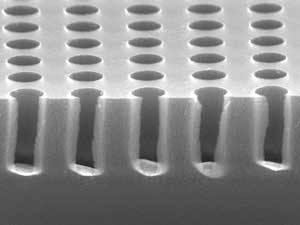| Posted: Jan 16, 2018 |
A catalyst for change in chemical nanohole etching
(Nanowerk News) Metal-assisted chemical etching, or ‘MacEtch’, is used to fabricate a range of nanostructures, but damaging movements of the catalyst during vertical etching processes hamper its wider use. Now, a team led by A*STAR have developed a technique that improves catalyst stability, paving the way for wider application (ACS Applied Materials & Interfaces, "Minimizing isolate catalyst motion in metal-assisted chemical etching for deep trenching of silicon nanohole array").
|
 |
| An example of directional etching for nanohole arrays of less than 500nm in diameter. (Image: A*STAR Institute of Materials Research and Engineering)
|
|
MacEtch is a wet etching method for fabricating nanostructures from patterned metal film. The simplicity, versatility, and cost effectiveness of MacEtch in silicon and other semiconductors have led to its use in the manufacture of a wide range of products, from electronic and optoelectronic devices to biological and chemical sensors, as well as energy harvesting technologies. These applications, however, use relatively large mesh catalyst structures.
|
|
When catalysts with smaller dimensions are used, forces acting on the catalyst cause it to move during the etching process, which limits their use in the fabrication of structures with high aspect ratios, such as nanoholes.
|
|
“Previously, it has been very difficult to achieve directional isolate catalyst etching, and [this] has been a major roadblock in its development,” explains Sing Yang Chiam from A*STAR’s Institute of Materials Research and Engineering. “Small feature sizes are especially important for fabricating filtration devices, but at these dimensions, etching becomes very challenging.”
|
|
Now, a technique for controlling the catalyst during the etching process, allowing for the fabrication of nanoholes in silicon with unprecedented aspect ratios, has been developed by Chiam and colleagues in collaboration with the National University of Singapore and the University of Illinois at Urbana-Champaign in the United States.
|
|
The researchers investigated isolate catalyst etching of regular gold disks of identical array spacing and catalyst thickness, formed using laser interference lithography. This allowed the team to study precise and isolated effects of the etching parameters, such as the etchant and doping concentrations, to understand the interface forces on the catalyst.
|
|
They found that higher ratios of hydrofluoric acid to hydrogen peroxide, or higher p-type silicon doping levels, reduce catalyst motion, and attributed this to a lowering of the interface Van der Waals forces caused by the creation of porous silicon.
|
|
The researchers demonstrated their technique by fabricating large-area, regularly ordered, nanoholes arrays in silicon with an aspect ratio of around 12. This new method enables the fabrication of new biological and water filters, and nanophotonic devices.
|
|
“We plan to use our findings to make a simple filtration device, and then see how much further we can take deep trenching,” says Chiam.
|

